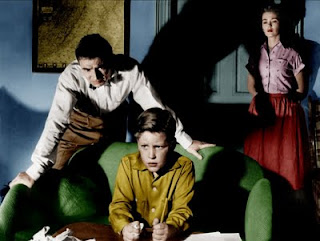
Father Knows Best
by Thomas Delapa
Of all the classic directors celebrated by auteur critics, few have generated the controversy—or the cult-like following—of Nicholas Ray. In his brief Hollywood career, Ray’s official reputation primarily rests on Rebel Without a Cause, which made a legend of James Dean rather than its director. While a few of Ray’s films have found a niche audience—like Johnny Guitar and In a Lonely Place—none has achieved the kind of pop-culture status of, say, Hitchcock’s Psycho or John Ford’s The Searchers.
If Ray’s critical stardom rose in the 1960s and 1970s and dimmed since, a new Ray revival is long overdue, particularly with the lustery, long-awaited DVD release of Bigger Than Life, the 1956 masterwork that may be his greatest film.
Big things can come in small packages, which is one reason to applaud Criterion’s release, which boasts a new 35mm digital transfer, deft audio commentary by Ray scholar Geoff Andrew, several short interviews (including one with Ray himself), and an essay booklet. Like many Ray films, Bigger Than Life has been practically insignificant as a video, even though it’s often regarded as one of the 1950s’ best (and most subversive) Hollywood features.
An acid test for classic auteurism that focuses on the director’s unique, subtextual style, Ray’s film adds up to much more than the sum of its parts: a script (partially written by playwright Clifford Odets) based on a New Yorker article on the ill effects of cortisone, the decade’s “wonder drug”; a wondrous range of acting by British lead James Mason, who also produced; and Ray’s grand feeling for mise-en-scene, which vividly blends color expressionism with the 20th Century Fox studio sets.
Mason plays Ed Avery, a frustrated teacher who moonlights for a cab company to pay the bills for the cozy suburban home he shares with his devoted wife Lou (Barbara Rush) and TV-loving son, Richie (Christopher Olsen). Not only does Ed hide his second job from his wife, but so too his mysterious affliction that strikes him with painful seizures.
For Ray—who studied architecture under Frank Lloyd Wright—the above-average Avery home is an organic embodiment of Ed’s dreams and frustrations. Decorated with travel posters, downstairs presents his (and his wife’s) public face, an image of success and normalcy. Upstairs is his private realm, where his inner self is exposed, revealing repressed demons of grandiosity and Nietzschean superiority. A potent Ray motif, he stages much of the defining action on the staircase, the off-kilter nexus between Ed's opposing worlds.
The catalyst for Ed’s transformation is a bunch of jagged little pills, namely cortisone, which have the potential of saving his life. But the side effect is Ed’s Jekyll-and-Hyde makeover into a nightmare version of patriarchy. In the Eisenhower decade of Father Knows Best and Leave It to Beaver, Ray makes room for Daddy all right, exposing him as a doppelganger father, a tragically diabolical cross between Vince Lombardi and the Biblical Abraham.
Not only does Ed deliver one of the most acrid speeches ever on the American education system (on P.T.A night, no less), he also devotes quality time to terrorizing his son, at one point turning an all-American glass of milk into his version of Capt. Queeg’s stolen strawberries. Always cowering in the background is Lou, fearful as much for preserving middle-class appearances as saving her own life.
While Ray’s Freudian undertones loom large, so does his prescient feminism that punctures the post-war masculine mystique. As Andrew treats in his commentary, Ray’s themes include aging and death as well as drug abuse (which Ray knew all too well). Yet his tight direction never sags under melodramatic weight, brilliantly allowing the acting and widescreen compositions to express the sizable themes.
Like many small-budget genre gems of the decade, Bigger Than Life truly came from the beneath the Fifties, drawing away the curtain to reveal the angst below the angora, the fear under the facade—and the monsters from the id.
------------







No comments:
Post a Comment